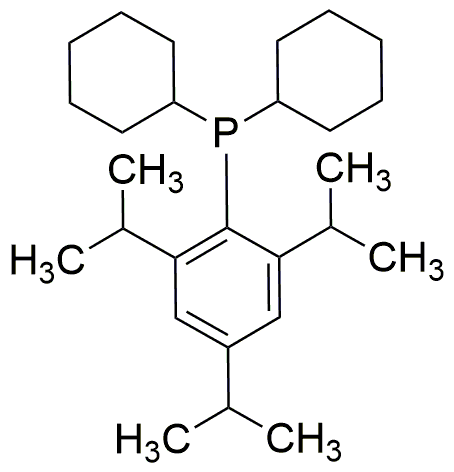Dicyclohexyl(2,4,6-triisopropylphenyl)phosphine is widely utilized in research focused on:
- Catalysis: This compound serves as a highly effective ligand in various catalytic processes, enhancing reaction rates and selectivity in organic synthesis, particularly in transition metal catalysis.
- Pharmaceutical Development: It plays a crucial role in the development of new pharmaceuticals by facilitating the synthesis of complex organic molecules, which can lead to the discovery of novel drugs.
- Material Science: The compound is employed in the formulation of advanced materials, including polymers and composites, due to its ability to improve mechanical properties and thermal stability.
- Environmental Applications: It is used in the development of catalysts for environmental remediation, helping to break down pollutants and reduce environmental impact in industrial processes.
- Research in Organometallic Chemistry: This chemical is significant in the study of organometallic compounds, aiding researchers in understanding bonding interactions and reactivity patterns in various chemical environments.
General Information
Properties
Safety and Regulations
Applications
Dicyclohexyl(2,4,6-triisopropylphenyl)phosphine is widely utilized in research focused on:
- Catalysis: This compound serves as a highly effective ligand in various catalytic processes, enhancing reaction rates and selectivity in organic synthesis, particularly in transition metal catalysis.
- Pharmaceutical Development: It plays a crucial role in the development of new pharmaceuticals by facilitating the synthesis of complex organic molecules, which can lead to the discovery of novel drugs.
- Material Science: The compound is employed in the formulation of advanced materials, including polymers and composites, due to its ability to improve mechanical properties and thermal stability.
- Environmental Applications: It is used in the development of catalysts for environmental remediation, helping to break down pollutants and reduce environmental impact in industrial processes.
- Research in Organometallic Chemistry: This chemical is significant in the study of organometallic compounds, aiding researchers in understanding bonding interactions and reactivity patterns in various chemical environments.
Documents
Safety Data Sheets (SDS)
The SDS provides comprehensive safety information on handling, storage, and disposal of the product.
Product Specification (PS)
The PS provides a comprehensive breakdown of the product’s properties, including chemical composition, physical state, purity, and storage requirements. It also details acceptable quality ranges and the product's intended applications.
Certificates of Analysis (COA)
Search for Certificates of Analysis (COA) by entering the products Lot Number. Lot and Batch Numbers can be found on a product’s label following the words ‘Lot’ or ‘Batch’.
Numéro de catalogue
Numéro de lot/série
Certificates Of Origin (COO)
This COO confirms the country where the product was manufactured, and also details the materials and components used in it and whether it is derived from natural, synthetic, or other specific sources. This certificate may be required for customs, trade, and regulatory compliance.
Numéro de catalogue
Numéro de lot/série
Safety Data Sheets (SDS)
The SDS provides comprehensive safety information on handling, storage, and disposal of the product.
DownloadProduct Specification (PS)
The PS provides a comprehensive breakdown of the product’s properties, including chemical composition, physical state, purity, and storage requirements. It also details acceptable quality ranges and the product's intended applications.
DownloadCertificates of Analysis (COA)
Search for Certificates of Analysis (COA) by entering the products Lot Number. Lot and Batch Numbers can be found on a product’s label following the words ‘Lot’ or ‘Batch’.
Numéro de catalogue
Numéro de lot/série
Certificates Of Origin (COO)
This COO confirms the country where the product was manufactured, and also details the materials and components used in it and whether it is derived from natural, synthetic, or other specific sources. This certificate may be required for customs, trade, and regulatory compliance.


